
About UsThe Numismatic Bibliomania Society is a non-profit organization promoting numismatic literature. For more information please see our web site at coinbooks.org SubscriptionsThose wishing to become new E-Sylum subscribers (or wishing to Unsubscribe) can go to the following web page link MembershipThere is a membership application available on the web site Membership Application To join, print the application and return it with your check to the address printed on the application. Membership is only $15 to addresses in the U.S., $20 for First Class mail, and $25 elsewhere. For those without web access, write to: David M. Sundman, Secretary/TreasurerNumismatic Bibliomania
Society AsylumFor Asylum mailing address changes and other membership questions, contact David at this email address: dsundman@LittletonCoin.com SubmissionsTo submit items for publication in The E-Sylum, just Reply to this message, or write to the Editor at this address: whomren@coinlibrary.com
BUY THE BOOK BEFORE THE COINYou won't regret it! |
- WAYNE'S WORDS: THE E-SYLUM OCTOBER 26, 2008
- FIRST FANNING NUMISMATIC LITERATURE AUCTION SALE CLOSES OCTOBER 28
- KARL MOULTON'S WINTER 2008 FIXED PRICE LIST
- NEW BOOK: ERIC NEWMAN'S EARLY PAPER MONEY OF AMERICA, FIFTH EDITION
- GLEANINGS FROM THE ASYLUM, JULY-SEPTEMBER 2008
- THOUGHTS ON SELF-PUBLISHING NUMISMATIC BOOKS
- MORE ON LOCATING NUMISMATIC LITERATURE ONLINE
- RESPONSES TO R.V. DEWEY'S 1856 GOLD DOLLAR IMAGE
- ENHANCED SIGNATURES ON MEDALS ADD CHARM
- QUERY: CONFEDERATE CURRENCY CATALOG CENSUS
- INDIAN PEACE MEDALS ON DISPLAY AT THE NATIONAL MUSEUM OF THE AMERICAN INDIAN
- PARIS AND NEW YORK CITY WORKSHOP ANNOUNCEMENTS
- DORA DE PEDERY-HUNT'S WINSTON CHURCHILL MEMORIAL PLAQUE
- MORE ON PRESIDENT GEORGE W. BUSH'S CHALLENGE COIN
- REFLECTIONS UPON BEING A COIN COLLECTOR BY R. W. MCLACHLAN
- ADDITIONAL READING ON WALDO NEWCOMER COLLECTION RARITIES
- COIN SHORTAGE HITS ARGENTINA
- RARE ANGLO-SAXON JEWELRY AND COINS FOUND AT BURIAL SITE
- STOLEN MEDALS RETURNING HOME TO WAIOURU ARMY MUSEUM, NEW ZEALAND
- RARE CANADIAN $500 BILL BRINGS $322,000 AT AUCTION
- STOLEN: GOLD MEDAL OF THE PATRON SAINT OF THIEVES
- FEATURED WEB PAGE: U.S. MINT ARCHIVE SEARCH
WAYNE'S WORDS: THE E-SYLUM OCTOBER 26, 2008
 Among our recent subscribers is Mark
Hartford, courtesy of John and Nancy Wilson. Welcome aboard! We now have
1,208 subscribers.
Among our recent subscribers is Mark
Hartford, courtesy of John and Nancy Wilson. Welcome aboard! We now have
1,208 subscribers.This week we open with a reminder of Tuesday's closing date for David Fanning's numismatic literature auction, so get those bid sheets in! Next up are some excerpts from Karl Moulton's new fixed price list. Lots of good reading material in this issue. It's getting late and rather than outline the rest of the issue as usual, I thought I'd work in a brief numismatic diary.
This weekend I travelled up to Pittsburgh for the Pennsylvania Association of Numismatists show at the Pittsburgh Expo Mart in Monroeville, PA. COIN World editor Beth Deisher was PAN's guest for the show and we had a few minutes to chat. Beth spoke to an enthusiastic audience of over 80 young numismatists on Saturday. PAN's Coins4Kids program is a notable achievement.
Numismatic bibliophile extraordinaire Dave Hirt of Frederick, MD was at the show along with his wife Emi, and we had a nice chat about our libraries and the recent Sklow literature sale.
I also had the pleasure of speaking with Richard Jewell, who had a marvelous exhibit on the Erie Canal Completion medal. Included in the exhibit were examples in bronze, silver and gold, plus two large plaques bearing the design of the medal. Rich had acquired these just recently, and they came from an old building alongside the canal by way of an antique dealer and an alert coin dealer. PAN's exhibit area is another show feature which only keeps getting better and better.
I was making the rounds of the show pedaling duplicates and other items to clean up my safe deposit box and raise some cash. The effort was successful, but tonight I pulled together another pile of recent acquisitions that need to go into that box. At least now I'll have a little more room.
It was great to see so many of my friends, and I regret not having had more time to talk. Among others I ran into were John Paul and Kathy Sarosi, Blaine and Ted Shiff, John Eshbach, Dick Duncan, Jerry Kochel, Ray Dillard, Don Carlucci, Sam Deep, Josh Wadsworth, Larry Dziubek, Richard and Eva Crosby, Dick Gaetano, Skip Culleiton, Corleen Chesonis, Bill Hunter and Paul Schultz. I missed former Asylum editor Tom Fort who had been there Saturday morning.
It was a whirlwind visit, but very satisfying. Thanks again to everyone. To learn what coins President Bush keeps behind the Resolute desk in The White House, read on. Have a great week, everyone!
Wayne Homren
Numismatic Bibliomania Society
FIRST FANNING NUMISMATIC LITERATURE AUCTION SALE CLOSES OCTOBER 28
David Fanning writes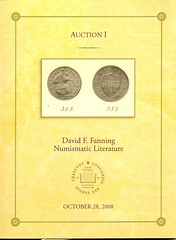
The limited hardcover edition has sold out, but copies of the regular edition remain available and will be sent for free to any bidder who didn.t receive one. Following the sale, they will be available with the PRL for $15 postpaid. Thanks to everyone who has submitted bids so far. We.re looking forward to an exciting sale.

KARL MOULTON'S WINTER 2008 FIXED PRICE LIST
Among the most desirable catalogues of the latter part of the 20th century. Few complete sets have been offered over the years with a hardbound set realizing over $1,000 at auction. Many notable U.S. and world coins were presented between 1997 and 1999.
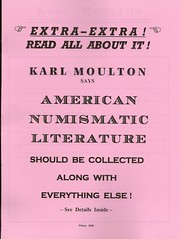
These Haseltine sales, long ignored because of their lack of promotion in the descriptions, are a veritable wealth of information to the serious numismatic researcher. A prime example of this can be found in this sale, which contains an 1838-O Half Dollar. You will not find this offering of an 1838-O Half mentioned in anyone.s pedigrees in any references because no one has taken the time to check. According to Haseltine.s information, at this early juncture, there were six examples known.
NEW BOOK: ERIC NEWMAN'S EARLY PAPER MONEY OF AMERICA, FIFTH EDITION
 The fifth edition of Eric P. Newman's Early
Paper Money of America, is now available from the publisher, Krause
Publications.
The fifth edition of Eric P. Newman's Early
Paper Money of America, is now available from the publisher, Krause
Publications.This long-awaited new edition pairs historical content with collector pricing. It includes coverage of paper money issues from Massachusetts Bay in 1696 and expanding south into Georgia.
In addition to extensive background details about development of paper money and information about Revolutionary War State issues, Continental Currency Issues, symbols and abbreviations, this new edition also includes notes from 17 individual states, appendices which address sheet structure, watermarks, emblematic legends, counterfeits and exchange values, and a color notes section.
This 495-page edition of Newman's tome features up-to-date pricing by Stuart Levine in the highest grades currently available.
Early Paper Money of America is KP catalog No. Z0101, and has a list price of $95. Receive free shipping when you order your copy by Nov. 20. Use Coupon Code BN1108 when you order online at www.krausebooks.com or call 800-258-0929 to order.
To read the complete article, see: Newman Classic in 5th Edition (http://www.numismaster.com/ta/numis/Article.jsp?
ad=article&ArticleId=5484)
GLEANINGS FROM THE ASYLUM, JULY-SEPTEMBER 2008
 The National Numismatic Collection (NNC,
formerly the Mint Cabinet), housed in the Smithsonian, represents the ne
plus ultra of American numismatic collections, yet the cataloguing and
documentation surrounding the collection is sadly not commensurate with
the breadth and quality of the collection itself. A researcher easily
locates the online catalogues of the American Numismatic Society, but is
more challenged when searching for similar resources applicable to the
NNC.
The National Numismatic Collection (NNC,
formerly the Mint Cabinet), housed in the Smithsonian, represents the ne
plus ultra of American numismatic collections, yet the cataloguing and
documentation surrounding the collection is sadly not commensurate with
the breadth and quality of the collection itself. A researcher easily
locates the online catalogues of the American Numismatic Society, but is
more challenged when searching for similar resources applicable to the
NNC.It is ironic that while two of the earliest American numismatic works (DuBois.s Pledges of History and Snowden.s Description of Ancient and Modern Coins), are focused on the NNC, there is currently no single comprehensive source describing the American content of the collection. Still, a number of researchers have made contributions towards cataloguing the American content of the NNC, and these efforts are herein enumerated.
Located in the National Museum of American History, Behring Center, the National Numismatics Collection (NNC) includes approximately 1.6 million objects, including over 450,000 coins, medals, and decorations and 1.1 million pieces of paper money. It embraces the entire numismatic history of the world.
William E. DuBois. Pledges of History: A Brief Account of the Collection of Coins Belonging to the Mint, More Especially the Antique Specimens. Philadelphia: C. Sherman, 1846.
O. C. Bosbyshell. An Index to the Coins and Medals of the Cabinet of the Mint of the United States at Philadelphia. Philadelphia: Avil Printing and Lithography Company, 1891.
Peter K Shireman. .Barber Halves at the Smithsonian.. Journal of the Barber Coin Collectors. Society 15 (no. 3): 13.16, 2004.
Here are some tips on how to convince a publisher that your manuscript will make a good addition to its sales list. (Note that I didn.t say, .. . . will make a good addition to the canon of numismatic literature.. Often the latter will encourage the former, but remember that the goal is to sell books. )
If I had a Buffalo nickel for every .great new book idea. I.ve been pitched, I.d be able to bankroll a small herd. Everyone has a pet topic: countermarked half cents; nineteenthcentury apothecary scrip of the Oswego River; trade dollar chopmarks that look like famous celebrities. (One of my pet topics: portrait medals of the German Kaiserreich.) A commercial publisher will want to know that the market will absorb more than a couple hundred copies.
THOUGHTS ON SELF-PUBLISHING NUMISMATIC BOOKS
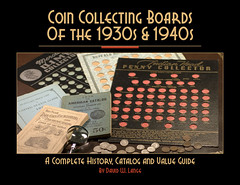 I'd like to comment about Dick Johnson's
remarks concerning self-publishing. In general I agree with them, though
he didn't note the possibility that an author having an obscure subject
may not be able to find a publisher. Perhaps this is not the case for
books about USA medals, but it certainly was for me when I attempted to
have my coin board book published commercially.
I'd like to comment about Dick Johnson's
remarks concerning self-publishing. In general I agree with them, though
he didn't note the possibility that an author having an obscure subject
may not be able to find a publisher. Perhaps this is not the case for
books about USA medals, but it certainly was for me when I attempted to
have my coin board book published commercially. It was turned down by the two most likely publishers of hobby books for the reason that they believed there would be insufficient interest to warrant marketing such a book. While they evidently know their business, I believe that such an approach is largely self-fulfilling. I've yet to find anyone who was disappointed with my book, and the only problem has been in getting enough people to learn of it in the first place. This is nearly impossible without an established marketing infrastructure.
As an example of what one is up against, I recently placed a color ad in Coin World which resulted in the sale of just three books. This is about a fifth the number to recover my cost for the ad, so it is not something I can do on a regular basis. Without the built-in marketing network of an established publisher, placing one's book with stores is not an option, aside from having a listing at Amazon.com.
The only remaining course of action is to pound the pavement, which I've doing with my book at every coin show I attend. Even then, the biggest sellers of coin books won't touch it without discounts of 60% or more from the list price. That is simply not possible in my case, as I wanted to keep the list price within the range of most hobbyists. We've all seen beautiful books that went begging because only a handful of bibliophiles would pay $300 for such a masterpiece.
Dick observed, too, that self-published books often lack proper editing and graphic design. This is certainly one of my bugaboos, having seen good text ruined by amateurish efforts at desk-top publishing. I was absolutely determined that my book would look good and would seem like a professionally published work. Of course, the extra expense of hiring a talented designer is one of the things preventing me from offering the hefty discounts that retailers demand, but it did result in a work of which I'm quite proud.
I performed all of the scanning of photos, ads and actual coin boards myself, as well as finishing these images in PhotoShop, but it was Mary Jo Meade who assembled the materials per my guidelines and crafted a beautiful book that met all the criteria required by the printer.
As for editing, I do so much of this myself in my career that I was confident of not needing outside assistance. While a handful of minor typos have been found in the year since my book was published, none of these have been significant enough to affect the its utility. I do plan to put out a list of errata and addenda, as well as an updated value guide, later this year.
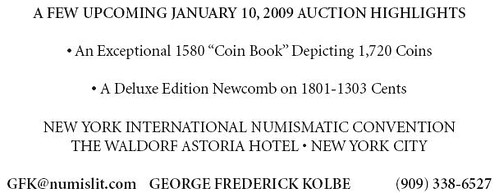
MORE ON LOCATING NUMISMATIC LITERATURE ONLINE
Regarding Scott Semans' query about the best sites for locating out of print numismatic literature online, Douglas Saville writes:In addition, of course, anyone searching for a particular title might try emailing me direct (info@douglassaville.com) - I have many more books in stock that are not listed on my website. I am talking specifically of numismatic books, of course. It just might be worth the effort!
Jim Duncan writes:
Emil Eusanio of the San Fernando Book Company writes:
RESPONSES TO R.V. DEWEY'S 1856 GOLD DOLLAR IMAGE
Last week R.V. Dewey shared with us an image of an 1856 $1 gold piece, which he believes could be an unlisted pattern. Our readers are quite skeptical.Tom DeLorey writes:
Saul Teichman writes:
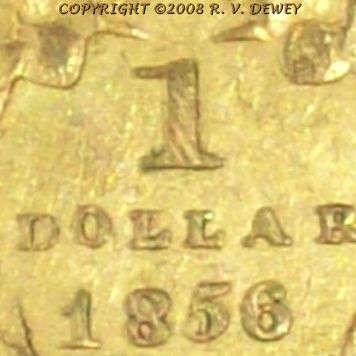
Bob Neale writes:
Phil Iverson writes:
Tom DeLorey adds:
ENHANCED SIGNATURES ON MEDALS ADD CHARM
Saint-Gaudens never used the same monogram twice in his medallic work. Not so with his large sculpture. But for his medals he would vary his ASG, sometimes including a T, sometimes not. It seems the more prominent an artist, the more they varied their signature. Several of The Society of Medalists medalists took the opportunity to enhance their monogram, probably because they had free reign not only in the design, but also in how they affixed their authorship.
In a study of over 500 monograms of 273 American medallists, here are some of the charming ways I found that these artists signed their works:
- . In 1915 John Flanagan of 1932 quarter fame placed his JF inside the last O of the Latin legend on the obverse of the Panama-Pacific International Exposition Medal of 1915. It was copied without authority but the replicators omitted the monogram, so the existence of the JF is a diagnostic of authenticity.
- . In 1957 Anthony de Francisci of Peace dollar fame added a boaster -- a sculptor's tool -- under his monogram on the United Parcel Service 50th Anniversary Medal. A bonus for UPS!
- . In 1949 famed artist David Smith placed a delta-S on a rock on the reverse of the Art News Amateur Painters Medal as his signature. Was the delta significant? Did it have a hidden meaning?
- . In 1933 Carl Paul Jennewein added a tiny outline of a self portrait next to his monogram above the date on the reverse of his Society of Medalists Issue Number 7.
- . In 1937 Robert I. Aitken on his Society of Medalists Issue number 15, which was concordant -- the reverse was the back of the obverse device, a pair of lovers locked in an embrace, as if it was in-the-round -- spelled out his last name in mirror image on the reverse. It amplified the evidence of the concordant theme.
- . In 1974 Spero Anaygros -- and I have mentioned this before in E-Sylum -- put a cattle brand on the haunch of a horse on the obverse of the Salinas California Centennial Medal, as an "S over A" brand. Now that is charming!
- . In 1975 Marcel Jovine -- and this is my favorite -- on his United States / Russian Apollo Soyuz Medal put the legend in English on one side and in Russian on the other. His name appeared in English on one side and in Cyrillic letters on the other!
QUERY: CONFEDERATE CURRENCY CATALOG CENSUS
My colleagues and I are attempting to determine the relative rarities of early Confederate currency catalogs, namely Lee.s 1875 catalog, Haseltine.s 1876 catalog, Thian.s 1885 catalog, and Massamore.s 1889 catalog, by taking a census of extant copies.
The works of interest are:
- Lee, William. The currency of the Confederate States of America, a description of the various notes. . . Washington: 1875.
- Haseltine, John W. Descriptive catalogue of Confederate notes and bonds. Philadelphia: Bavis & Pennypacker, Steam Power Printers, 1876. (note: this publication is sometimes bound with Haseltine.s 1872 pamphlet on Continental currency)
- Thian, Raphael P. The currency of the Confederate States, arranged by issues, denominations and series. Washington: 1885.
- Massamore, George W. Descriptive and chronological catalogue of Confederate currency. Baltimore: Massamore, 1889.
If readers of The E-Sylum having copies of these publications would notify me at fred@spmc.org, I would be most thankful. I can keep correspondents. identities confidential, and Confederate currency collectors and numismatic bibliophiles will have better information available.
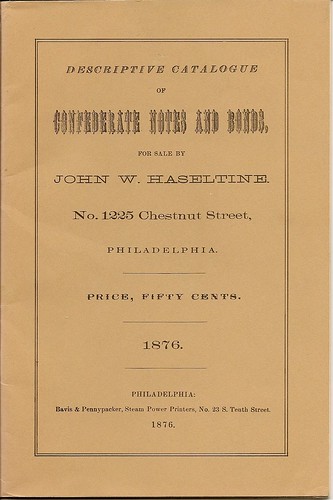
- The Thian Confederate Note Album
- A Lyman Low fixed price list of Paper Money of the Confederate States
- Mercer's Price List of Confederate Notes, Etc.
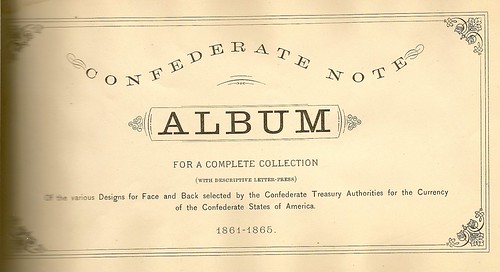
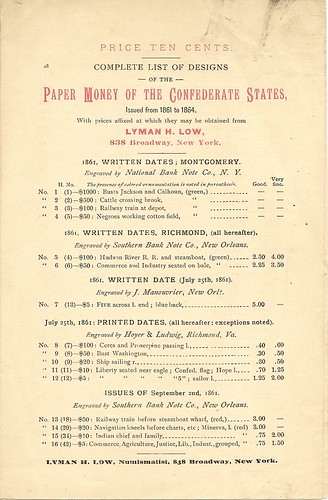
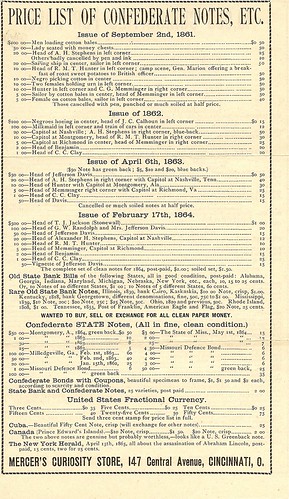
INDIAN PEACE MEDALS ON DISPLAY AT THE NATIONAL MUSEUM OF THE AMERICAN INDIAN
Max Spiegel writes:There are a few other medals but that was definitely the most impressive one. In the Our Peoples gallery, there are also several dozen coins (many on loan from the ANS) on display to illustrate European money during colonization. If anyone happens to be in D.C. and is disappointed that the American History Museum is closed for renovation and the Smithsonian Castle no longer has the Legendary coins exhibit, I would suggest that they check out the National Museum of the American Indian. (The museum also has a pretty interesting food court!)
PARIS AND NEW YORK CITY WORKSHOP ANNOUNCEMENTS
The workshop is hosted by Georges Depeyrot (CNRS and the EHESS) and the first part on Revisiting Money As A Unified Unit Of Account From A Complementary Viewpoint is organized by Professors Kuroda (Tokyo University) and Bruno Thiret (IRISES, CNRS Universiti Paris Dauphine). The second part concerns the project on Paper Money in Theory and Practice in History and is organized by Anders Vgren (EHFF/SSE and EconomiX/Universiti de Paris X) and Patrice Baubeau (IDHE/Universiti de Paris X). More info will be sent out within short.
Also, please find enclosed a call for papers for a three day conference on Paper Money in Theory and Practice in History. This conference will be organized by Anders Vgren, David F. Weiman (Department of Economics, Barnard College, Columbia University) and Carl Wennerlind (Department of History, Barnard College, Columbia University).
The conference will take place at Barnard College, Columbia University in New York City in April 17-19, 2009. The deadlines are December 15, 2008 for the abstract and March 30, 2009 for the full papers.
From the Call for Papers:
While the existence of paper money, credit money, and fiat money systems have not been at the center of modern economic research, there is a long history of prominent thinkers who carefully theorized the emergence and dynamics of such monetary systems. In Europe, thinkers like John Law, Richard Cantillon, David Hume, and Henry Thornton developed elaborate theoretical frameworks, while in the American colonies, Benjamin Franklin famously explored the use of paper money. In addition to the western tradition of using and thinking about paper money, the Chinese economy was based on paper money for many centuries.
The fact that paper money existed in so many different economies and political systems, suggests that a comparative approach to the theory and practice of paper money might be advantageous.
By exploring the common features of various paper money systems, the aim of this conference is to provide a deeper understanding of the nature, function, and dynamics of fiduciary coins, paper money, credit money, and fiat money.
THE BOOK BAZARRE
DORA DE PEDERY-HUNT'S WINSTON CHURCHILL MEMORIAL PLAQUE
Harry Waterson writes:I have searched for an image of this plaquette but haven't found one other than in the book. There were only 8 struck according to Engstrom, so it's a fairly rare piece.
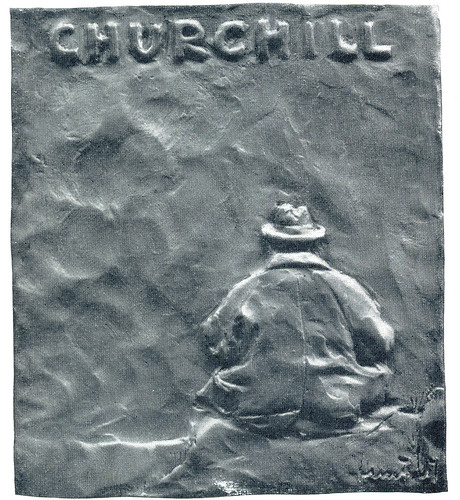
MORE ON PRESIDENT GEORGE W. BUSH'S CHALLENGE COIN
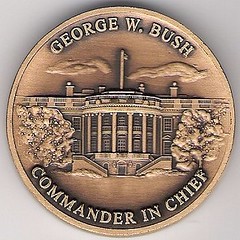
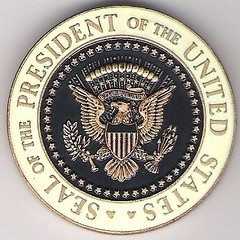
Regarding our earlier article on President George W. Bush's challenge coin, web site visitor Hugh Knaus of Fort Collins, CO writes:
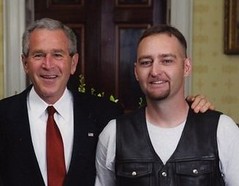 My coin is now encased in an archival mounted
picture frame that I had custom built and includes an autographed photo of
President Bush, my wife, and I, and a 1-page card that says "With
Compliments of the President". The frame is glass on both sides so that
both sides of the coin can be seen. Have you received any information as
to where it was minted? Do you have any other details about it?
My coin is now encased in an archival mounted
picture frame that I had custom built and includes an autographed photo of
President Bush, my wife, and I, and a 1-page card that says "With
Compliments of the President". The frame is glass on both sides so that
both sides of the coin can be seen. Have you received any information as
to where it was minted? Do you have any other details about it?I remember that behind the Resolute desk is where the President opened a cabinet drawer, inside was a red velvet lined wood case that must have contained about a hundred examples of the Bush challenge coin. I should also mention that everyone in the photo received a coin and that a couple people received two.
Searching Google for "President Bush challenge coin" I found this one for sale ($995.00): http://www.mountain-skies.org/challengeCPg1.htm
To read the earlier E-Sylum article, see: PRESIDENT GEORGE W. BUSH'S CHALLENGE COIN (http://www.coinbooks.org/esylum_v10n18a22.html)
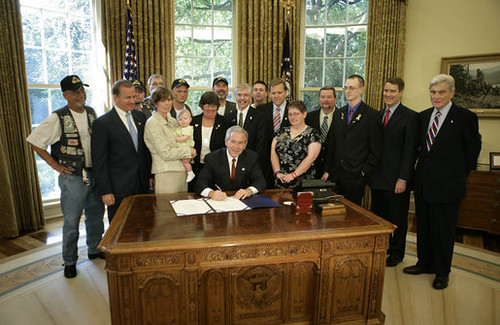
To read the complete article, see: George W. Bush signs H.R. 5037, the Respect for America's Fallen Heroes Act (http://www.whitehouse.gov/news/releases/2006/05/
images/20060529_p052906pm-0324-515h.html)
REFLECTIONS UPON BEING A COIN COLLECTOR BY R. W. MCLACHLAN
Originally published in The Numismatist in 1911 and later in The CN Journal Vol. 6, No. 12 December 1961, Jan., Mar., 1962, the article is a wonderful account of the 19th century numismatic world. The full article is well worth seeking out. It's the kind of first-hand account I relish publishing in The E-Sylum.
Bronsdon recommended the purchase of a coin cabinet, for he thought that no one could seriously concentrate on a series without some system of classification; in his opinion larger numbers of pieces, varieties included, might scarcely be classified without proper housing. Such wholesome advice, followed to the best of my ability, led me into the truest pleasures of numismatics. His friendship for me initiated that Canadian collection which has continued to grow ever since until now (October 1911) when, including coins, tokens and medals, it numbers well on towards five thousand pieces.
Some days I received three or four slugs, both round and octagonal, exchanged at not more than 548 each. Numerous U.S. 55, $10, and $20 goldpieces arrived, too, including Pike.s Peak Bechtlers, California Assay Office specimens and the like, but I never saw any- Mormon issues, though constantly on the watch for them.
American silver included a fair number of their pre-1837 dates, considered of superior intrinsic value to subsequent ones. These early United States coins did not come to us from their country of origin at that time. however, but were released by French Canadian habitants who had hoarded them, long before, soon after minting and their importation hither; hence, they usually turned up in Extremely Fine condition.
Along with other such items, I secured an unusually beautiful 1796 Half Dollar . but a Vermont collector begged so hard, a few years ago, that he got it from me.
I well remember the day of their advent in that place, and immediately purchasing one as a curiosity. Throwing the acquisition into a box, I completely forgot about its existence and certainly never considered Weir & Larminie.s encased U.S. stamp to be a coin. When it later commenced selling at prices above two dollars, however, this jogged my memory and out the specimen came from its previous, less dignified hiding-place to repose among rarities.
You have here the Weir & Larminie token.s explanation and an answer to that frequent question, .How did an encased United States postage stamp ever come to he issued in Canada?. Neither issued nor circulated in the normal way, it can only he classified as a freak advertisement put out by two Montreal exchange brokers.
Editor Dan Gosling adds:
The concept of whom articles are suited for and how many should be in Association publications would make a great thread.
ADDITIONAL READING ON WALDO NEWCOMER COLLECTION RARITIES
You must be an ANA member to access the site. The original article had some 30 photographs of Newcomer coins--hopefully ANA will post some of these photos as an addenda to the typed-script article.
If any of our readers have questions about Newcomer material or specific questions as to where the coins are today, contact me at fuld1@comcast.net .
THE BOOK BAZARRE
COIN SHORTAGE HITS ARGENTINA
 A kiosk owner bribes a bank worker with cookies
to break bills. Subway workers let commuters ride free because they can't
change their cash. Bus companies resell the coins they collect at a steep
black market markup.
A kiosk owner bribes a bank worker with cookies
to break bills. Subway workers let commuters ride free because they can't
change their cash. Bus companies resell the coins they collect at a steep
black market markup.Argentines are increasingly scrambling to get their hands on pocket change for everyday transactions, as soaring inflation makes the copper and aluminum that coins are made of worth more than their face value. Many suspect profit-seeking hoarders are scooping them up to stow away.
Argentine annual inflation officially hit 8.7 per cent in September, but independent economists say the government is lowballing that rate, which they claim is closer to 25 per cent.
One peso . worth about 31 cents U.S. . now buys so little that it makes more sense to melt down its metal than to save the 20 pesos it would take to buy an average box of chocolates, said economist Diego Giacomini, a consultant at Economia & Regiones in Buenos Aires.
An anonymous central bank hot line has meanwhile received 5,000 complaints about black market coin sales since it opened in February, according to the bank.
Each 50 cent coin contains about 5.3 grams of copper and 0.5 grams of aluminum, together worth about a sixth of the coin's monetary value. But inflation is rising so fast that in a few years, the coins will be worth less than the metal they are made of.
To read the complete article, see: In Argentina, inflation sparks scramble for coins (http://www.reportonbusiness.com/servlet/story
/RTGAM.20081017.wargentina1018/BNStory/Business/home?cid=al_gam_mostview)
RARE ANGLO-SAXON JEWELRY AND COINS FOUND AT BURIAL SITE
Arthur Shippee forwarded this story of finds at an Anglo-Saxon burial site. He writes: Exciting archeological finds dating back to the
seventh century have been ruled to be treasure during five separate
inquests at Teesside Coroners. Court.
Exciting archeological finds dating back to the
seventh century have been ruled to be treasure during five separate
inquests at Teesside Coroners. Court. Experts have described the finds as .unparallel in the North East. after historians discovered 109 graves near Loftus from around 650AD - one of which is thought to have contained the body of a princess.
Though the acidity in the soil means the remains no longer exist, dozens of high status items have stood the test of time including brooches, pendants, glass beads, pottery, and coins dating as far back as 43AD.
To read the complete article, see: Rare finds unearth Teesside link with royalty (http://www.gazettelive.co.uk/news/teesside-news/
2008/10/14/rare-finds-unearth-teesside-link-with-royalty-84229-22029051/)
STOLEN MEDALS RETURNING HOME TO WAIOURU ARMY MUSEUM, NEW ZEALAND
 Almost a year after the military medals stolen
were snatched in a heist from the Waiouru Army Museum in December, they
are about to take pride of place again.
Almost a year after the military medals stolen
were snatched in a heist from the Waiouru Army Museum in December, they
are about to take pride of place again. Ninety-six medals, including nine Victoria Crosses, were recovered in February but have been kept under lock and key.
Now, there will be a handover ceremony to the museum curators in Waiouru on Tuesday.
The ceremony will involve all three services as well as police and run for about half a day from early morning.
The army says the focus of the ceremony will be the families of those who won the medals, taken in a daring smash and grab which prompted public outrage.
And amongst them is a descendant of a Kiwi hero whose medal was stolen on that fateful December morning.
"His name is Reginald Stanley Judson, he is my great, great grandfather and he got his Victoria Cross for bravery in France," says Tipene O'Brien, army recruit and Judson's great, great grandson.
"I am very proud. It's pretty good that we get the chance to take it back to the museum, bit silly that it got taken but it's awesome."
Security has been upgraded at the museum since the theft and the army says it is confident the medals will be well protected.
To read the complete article, see:
(http://tvnz.co.nz/view/page/536641/2217256)
RARE CANADIAN $500 BILL BRINGS $322,000 AT AUCTION
The bank note - its sale price hailed as an "all-time record for a piece of Canadian paper money" - was first found 20 years ago in an old book by an unnamed Canadian man, and was recently re-discovered among a pile of papers being readied for a shredder.
"Its existence represents a true miracle of survival," announced Heritage Auction Galleries, the Dallas-based collectibles giant that handled the sale.
The Queen Mary note is so rare it's absent even from the Bank of Canada's own currency collection in Ottawa, experts said.
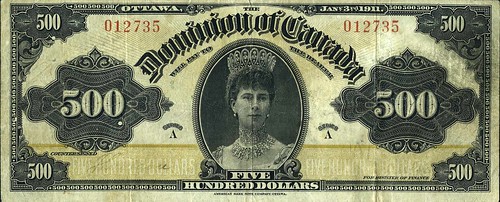
"It's a remarkable story," said MacDonald. "Someone was sifting through paper on a desk and shredding documents. And just prior to shredding a handful of documents, this $500 note dropped out and was brought in for discussion to see if it had any value. It was a true discovery note - and importantly, it's in better condition than the other two that exist."
MacDonald said the chances of any $500 bill from 1911 or 1925 remaining in private hands through Great Depression and surviving intact until today were extremely slim.
To read the complete article, see: Rare Canadian $500 bill brings in $322,000 at auction (http://www.canada.com/topics/news/national/
story.html?id=85e95e80-ee91-4af1-b131-69ff909fe1d9)
STOLEN: GOLD MEDAL OF THE PATRON SAINT OF THIEVES
-Editor
The stolen medal depicted St. Nicholas, who in addition to being the inspiration for Santa Claus is the patron saint of repentant thieves.
To read the complete article, see: Patron saint of thieves depicted on medal stolen from area home (http://www.pantagraph.com/articles/2008/10/22/
news/doc48ff21cb3a578061009458.txt)
FEATURED WEB PAGE: U.S. MINT ARCHIVE SEARCH
This week's featured web page is recommended by Len Augsburger. He writes:From the web page:
usmint.gov/historianscorner/index.cfm?action=ArchSearch
